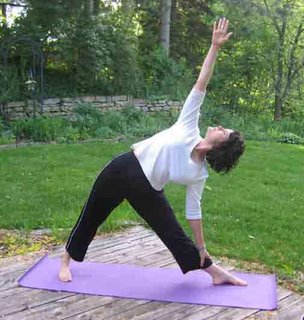
I once had a teacher who recommended “a dog a day” as a healthy yoga habit, and I find it to be as true as the admonition on apples. It is one of the most efficient poses and engages all the usual trouble spots with an elegant folding and inverting of the body. Shoulders stabilize while the back extends; hips lift while the legs lengthen. The head is lower than the heart, which calms the mind, while the large muscles of the back and legs are energized in order to ground through the hands and feet. This combination of engagement and release is what makes Adho Mukha Svanasana (Downward Facing Dog) such an effective pose.
Downward Dog is very adaptable and it is fun to try different modifications to see how the pose changes depending on where your body is placed. Experiment to see which variation best complements your regular Dog. You can:
-Lift your heels three or four inches and press them to the wall instead of the floor. Notice the additional rotation in the shoulders.
-Press the inside edge of the hands to the wall and feel the heels stretch closer to the floor, opening the backs of the legs.
-Place the hands and feet as wide as your mat and feel the engagement in the back muscles.
-Invert the dog at the wall by pressing the hands to the wall at hip height and stepping the feet back until they are beneath the hips--making a right angle between the body and legs. Notice how this position stretches the armpits and sides of the torso. You can deepen the rotation in the shoulders by relaxing the upper back and letting the head hang between the arms (this is a good modification if a regular Dog is too much weight on your arms and wrists).
If you don’t have time to do anything else, or it is your day off from yoga, try to press up into a Dog for a quick 5-minute session. It is a complete practice in itself, especially if you can hold it long enough to let your mind settle into the rhythm of your breath. There is nothing more exhilarating than entering the weightless feeling of a completely balanced Downward-Facing Dog!
Practice
If you have a half-hour, here is a simple sequence, culminating with a freeing Downward-Facing Dog:
-Sukhasana (seated meditation)-concentrate on lengthening the spine so the back muscles are warmed.
-Hastasana (overhead arm stretch)-keep the shoulders low as you press your palms to the ceiling.
-Dandasana (Staff pose)-begin to warm the leg muscles.
-Padangusthasana (Hand-to-Big Toe pose)-focus on opening the backs of the calves and thighs.
-Tadasana (Mountain)-continue the alignment from the earlier Sukhasana as you stand.
-Gomukhasana-arms only (Cow’s head pose)-focus on the rotation in the shoulders as you stretch each elbow away from the other and toward the center.
-Uttanasana (Intense forward bend)-fold from the hips and release the head towards the floor, stretching out the spine.
- Adho Mukha Svanasana (Downward-facing dog)-come up from hands and knees, lifting the tailbone up as you ground down through the palms of the hands and soles of the feet…find the center of the pose so the hands and feet are supporting your weight equally.
-Balasana (Child’s pose)-fold down to the mat, resting the head and arms on the floor and releasing the hips.
-Twist- roll to the back and let the knees fall to one side, while grounding through the shoulders, then repeat with the knees on the other side.
-Savasana (Corpse Pose)-relax with the arms and legs outstretched and let the body release to the floor with each exhale. ©Brenda K. Plakans. All Rights Reserved.

